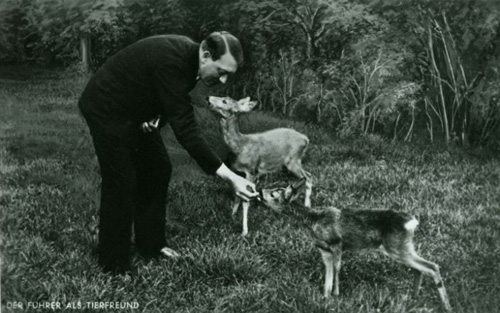New York
On March 16, 1941 – with European cities ablaze and Jews being herded into ghettos – The New York Times Magazine featured an illustrated story on Adolf Hitler’s retreat in the Berchtesgaden Alps.
Adopting a neutral tone, correspondent C Brooks Peters noted that historians of the future would do well to look at the importance of “the Führer’s private and personal domain,” where discussions about the war front were interspersed with “strolls with his three sheep dogs along majestic mountain trails.”
For more than 70 years, we have ignored Peters’s call to take Hitler’s domestic spaces seriously. When we think of the stage sets of Hitler’s political power, we are more apt to envision the Nuremberg Rally Grounds than his living room.
Yet it was through the architecture, design and media depictions of his homes that the Nazi regime fostered a myth of the private Hitler as peaceable homebody and good neighbor.
In the years leading up to World War II, this image was used strategically and effectively, both within Germany and abroad, to distance the dictator from his violent and cruel policies. Even after the war began, the favorable impression of the off-duty Führer playing with dogs and children did not immediately fade.
Nazi mythologies about Hitler’s origins emphasized his poverty and homelessness as a young man, as well as his disdain for creature comforts.
But once Hitler became chancellor – and particularly after the royalties from Mein Kampf made him a wealthy man – he focused considerable energies on the redesign and furnishing of his residences: the Old Chancellery in Berlin; his Munich apartment; and the Berghof, his mountain home on the Obersalzberg.
The timing of these renovations in the mid-1930s coincided with Hitler’s public makeover as a statesman and diplomat, a transformation also promoted by Leni Riefenstahl’s Nazi propaganda films.
The rough edges of the extreme anti-Semite and agitator of the masses were sanded away through the creation of a new, sophisticated persona that emerged in carefully crafted domestic surroundings. With silk curtains and porcelain vases, Hitler’s designers suggested an internal world that was both cultivated and peaceful.
Gerdy Troost, Hitler’s interior decorator, played an important role in conveying an image of her client as a man of taste and culture. Inspired by British design reform movements, she emphasized quality of materials and craftsmanship over showy display.
Hitler was an engaged client, and he admired her taste, although they sometimes clashed over his tendency toward the grandiose. A woman both respected and feared in Nazi Germany, Troost has been overlooked in histories written about the period. However new archival sources reveal the surprising extent of her influence over Hitler and her prominence within Nazi elite circles.
Hitler’s chalet With views of Germany on one side of the mountain and Austria on the other, the Berghof was the most public of Hitler’s private homes, and it exerted a powerful hold on the Nazi imagination of empire.
Hitler and his publicists drew on mountain imagery from Germany’s literary and artistic movements (particularly Romanticism) to mythologize the Führer as a mystic leader who immersed himself in – and embodied – the terrible and magnificent forces of nature.
At the same time, the mountain served as a means to humanize Germany’s leader through his contact with animals as well as with children. In officially produced postcards, magazines and books, Germans consumed fantasies about an ideal domestic life rooted in the natural landscape.—Agencies










